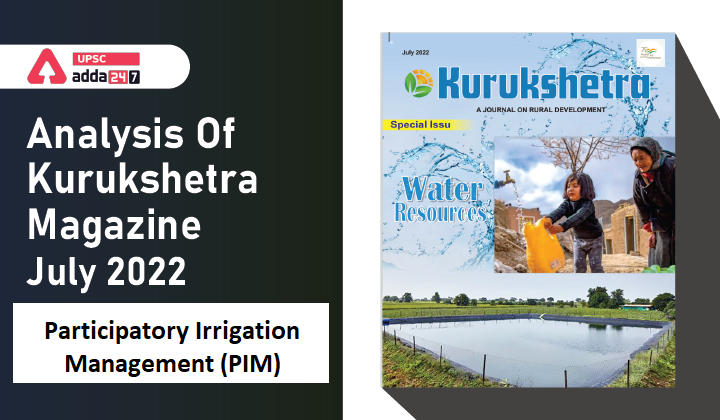Table of Contents
Kurukshetra is a Monthly Magazine which is issued by the Publications Division of the GOI.
Kurukshetra Magazine is one of the most important and indispensable source for UPSC Civil Services Exam Preparation. Keeping this in mind, here, we come with ”Analysis Of Kurukshetra Magazine” on daily basis, which covers the monthly Kurukshetra Magazine in easy and smooth pointed form, keeping in mind the demand of UPSC aspirants.
Considering the stern need of awareness regarding water resource management, the theme of this July 2022 special issue of Kurukshetra is Water Resources.
Participatory Irrigation Management (PIM): Background
- The concept of involvement of farmers in management of the irrigation system has been accepted as a policy of the Government of India and has been included in the National Water Policy adopted in 1987.
- Recognising the need to provide legal backup to PIM in the country, the Ministry of Water Resources commissioned an NGO, ”Society for Peoples’ Participation in Ecosystem Management (SOPPECOM)” Pune.
What is Participatory Irrigation Management (PIM)?
- Participatory Irrigation Management (PIM) broadly refers to the formation of groups of water users, mainly farmers, in a formal body for the purpose of managing parts or whole of an irrigation system.
- Such bodies are generally called Water Users’ Associations (WUA) but are also known by the names such as Pani Panchayat, Pani Samiti or irrigation cooperatives.
- PIM policy of the Government of India aims to create a sense of ownership of water resources and irrigation system among the users, so as to promote economy and efficiency in water use.
- Such type of ownership encourages better use of water through better choice of crops, cropping sequences and also regulates timing, period and frequency of water supply for optimum utilisation of irrigation water.
Participatory Irrigation Management (PIM): Farmer’s Responsibility
- In this approach, water users/farmers are involved as active stakeholders in the management of irrigation systems right from planning and design to construction, design, maintenance, distribution and even financing.
- In PIM based irrigation systems, it is the combined responsibility of the farmers to collect water charges from users and make payment to irrigation agency.
- Thus, a healthy relationship gets created and maintained between the irrigation agency and users.
Participatory Irrigation Management (PIM): Legal Framework
- To develop and popularise PIM as a viable tool of irrigation water management, a legal framework was needed in the country.
- Accordingly, the Ministry of Water Resources brought out a Model Act to be adopted by State Legislatures for enacting new irrigation acts or amending the existing ones to facilitate PIM.
- A good number of States have enacted new irrigation acts which now govern/regulate the constitution
and functioning of Water Users Associations.
Participatory Irrigation Management (PIM): Functions Of Farmer’s Organization at Different Levels
Farmer Organisations are tier for minor and medium irrigation projects, 3-tier for major irrigation projects are mentioned below:
Water User’ Association (WUA)
- In a WUA, all water users are its members and it has a Managing Committee (President and 4-10
members). - Each WUA has a delineated command area. Generally, it covers a group of outlets or a minor irrigation system.
Distributary committee (DC)
- It comprises five or more WUAs. All the presidents of WUAs will comprise general body of the
Distributary Committee.
Project Committee (PC)
- This is the apex committee of an irrigation system and presidents of the DCs in the project area shall
constitute general body of the PC.
Importance of PIM under Restructured CADWM Programme
- Under Restructured Command Area Development & Water Management Programme more emphasis is being given to the participatory approach. Under this programme, payment of central assistance to States is linked with the formation of Water Users‟ Associations.
- Apart from this, farmers will have to contribute a minimum of 10% cost of the works in form of cash/labour in three components namely, construction of field channels, reclamation of water logged areas, and desilting and renovation of MI tanks.



 TSPSC Group 1 Question Paper 2024, Downl...
TSPSC Group 1 Question Paper 2024, Downl...
 TSPSC Group 1 Answer key 2024 Out, Downl...
TSPSC Group 1 Answer key 2024 Out, Downl...
 UPSC Prelims 2024 Question Paper, Downlo...
UPSC Prelims 2024 Question Paper, Downlo...
